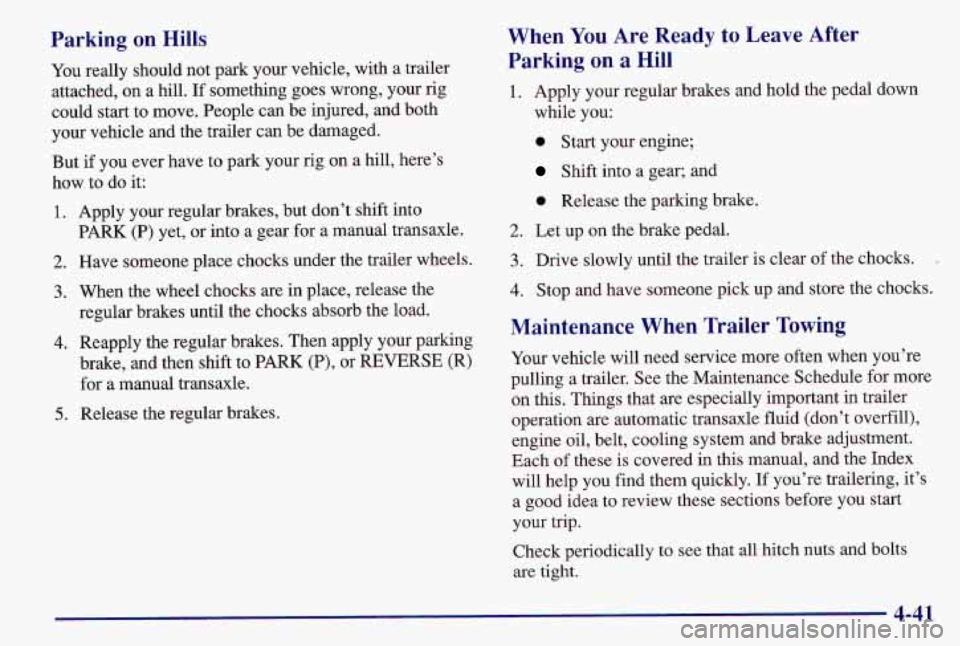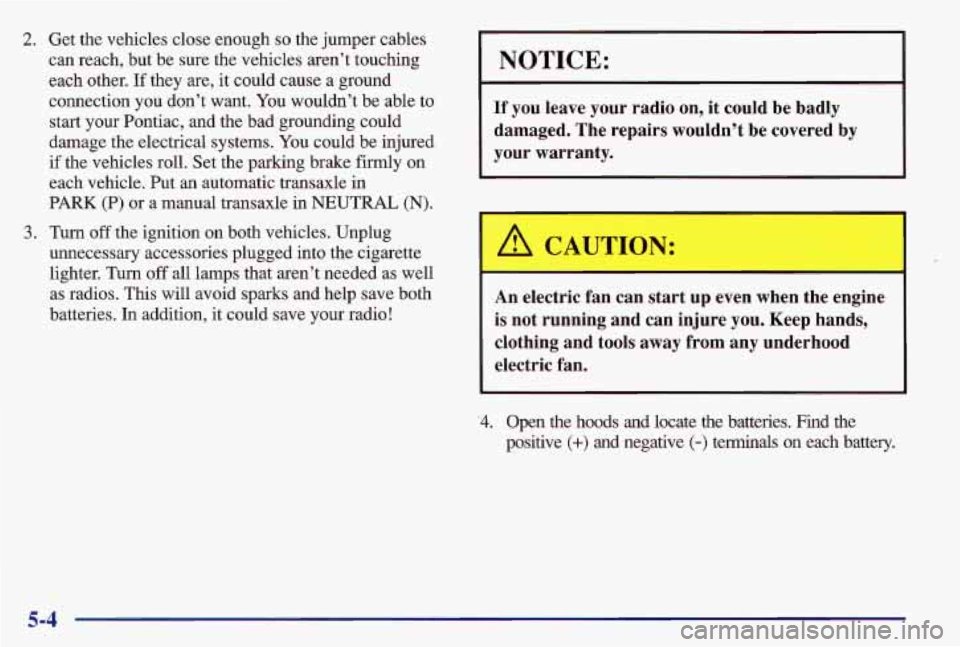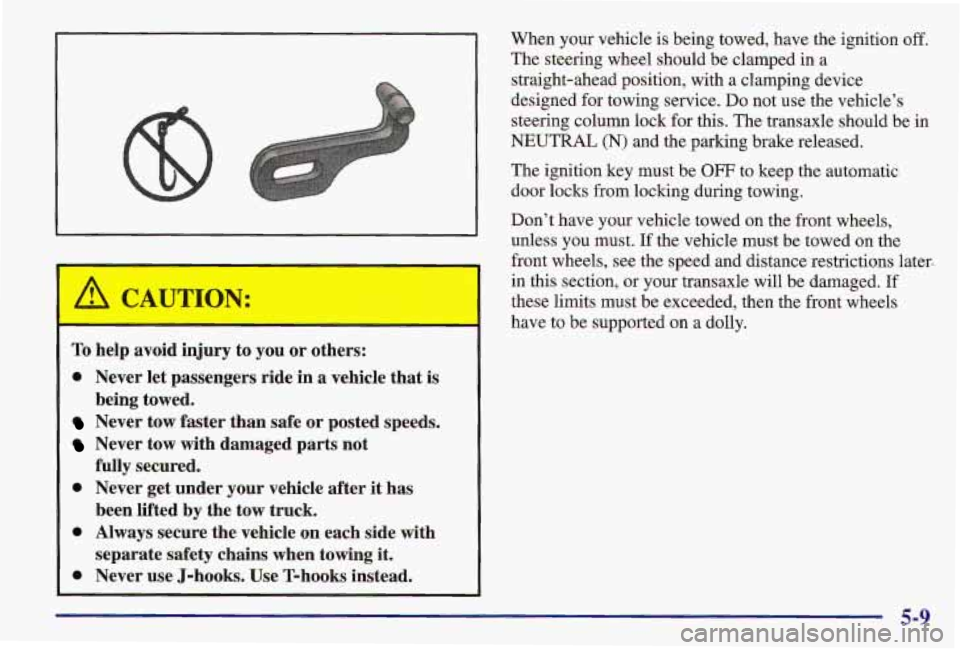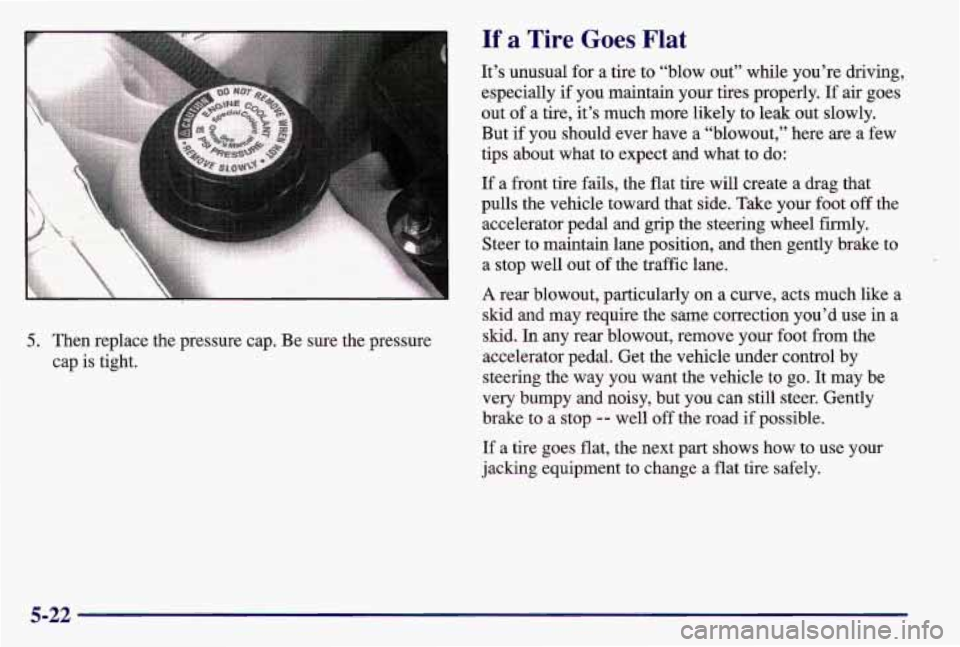Page 192 of 371

Parking on Hills
You really should not park your vehicle, with a trailer
attached, on a hill.
If something goes wrong, your rig
could start to move. People can be injured, and both
your vehicle and the trailer can be damaged.
But if you ever have to park your
rig on a hill, here’s
how to do it:
1. Apply your regular brakes, but don’t shift into
PARK
(P) yet, or into a gear for a manual transaxle.
2. Have someone place chocks under the trailer wheels.
3. When the wheel chocks are in place, release the
regular brakes until the chocks absorb the load.
4. Reapply the regular brakes. Then apply your parking
brake, and then shift to PARK
(P), or REVERSE (R)
for a manual transaxle.
5. Release the regular brakes.
When You Are Ready to Leave After
Parking
on a Hill
1. Apply your regular brakes and hold the pedal down
while you:
0 Start your engine;
Shift into a gear; and
0 Release the parking brake.
2. Let up on the brake pedal.
3. Drive slowly until the trailer is clear of the chocks.
4. Stop and have someone pick up and store the chocks.
Maintenance When Trailer Towing
Your vehicle will need service more often when you’re
pulling a trailer. See the Maintenance Schedule for more
on this. Things that are especially important in trailer
operation are automatic transaxle fluid (don’t overfill),
engine oil, belt, cooling system and brake adjustment.
Each
of these is covered in this manual, and the Index
will help you find them quickly.
If you’re trailering, it’s
a good idea to review these sections before you start
your trip.
Check periodically to see that all hitch nuts and bolts
are tight.
4-41
Page 197 of 371

2. Get the vehicles close enough so the jumper cables
can reach, but be sure the vehicles aren’t touching
each other. If they are, it could cause a ground
connection you don’t want. You wouldn’t be able to
start your Pontiac, and the bad grounding could
damage the electrical systems. You could be injured
if the vehicles roll. Set the parking brake firmly on
each vehicle. Put
an automatic transaxle in
PARK
(P) or a manual transaxle in NEUTRAL (N).
3. Turn off the ignition on both vehicles, Unplug
unnecessary accessories plugged into the cigarette
lighter. Turn off all lamps that aren’t needed as well
as radios. This will avoid sparks and help save both
batteries. In addition,
it could save your radio!
I NOTICE:
If you leave your radio on, it could be badly
damaged. The repairs wouldn’t be covered by
your warranty.
A CAUTION:
I -i
An electric fan can start up even when the engine
is not running and can injure you. Keep hands,
clothing and tools away from any underhood
electric fan.
‘4. Open the hoods and locate the batteries. Find the
positive
(+) and negative (-) terminals on each battery.
5-4
Page 202 of 371

I a CAUTION:
To help avoid injury to you or others:
0 Never let passengers ride in a vehicle that is
Never tow faster than safe or posted speeds.
Never tow with damaged parts not
fully secured.
0 Never get under your vehicle after it has
been lifted by the tow truck.
0 Always secure the vehicle on each side with
separate safety chains when towing
it.
0 Never use J-hooks. Use T-hooks instead.
being
towed. When your
vehicle is being towed, have the ignition off.
The steering wheel should be clamped in a
straight-ahead position, with a clamping device
designed for towing service.
Do not use the vehicle’s
steering column lock for this. The transaxle should be in
NEUTRAL (N) and the parking brake released.
The ignition key must be
OFF to keep the automatic
door locks from locking during towing.
Don’t have your vehicle towed on the front wheels,
unless you must. If the vehicle must be towed on the
front wheels, see the speed and distance restrictions later-
in this section, or your transaxle will be damaged. If
these limits must be exceeded, then the front wheels
have to be supported on a dolly.
5-9
Page 215 of 371

5. Then replace the pressure cap. Be sure the pressure
cap is tight.
If a Tire Goes Flat
It’s unusual for a tire to “blow out” while you’re driving,
especially
if you maintain your tires properly. If air goes
out of a tire, it’s much more likely to leak out slowly.
But
if you should ever have a “blowout,” here are a few
tips about what to expect and what to do:
If a front tire fails, the flat tire will create a drag that
pulls the vehicle toward that side. Take your foot
off the
accelerator pedal and grip the steering wheel firmly.
Steer to maintain lane position, and then gently brake to
a stop well out of the traffic lane.
A rear blowout, particularly on a curve, acts much like a
skid and may require the same correction you’d use
in a
skid. In any rear blowout, remove your foot from the
accelerator pedal. Get the vehicle under control by
steering the way you want the vehicle to go. It may be
very bumpy and noisy, but you can still steer. Gently
brake to a stop
-- well off the road if possible.
If a tire goes flat, the next part shows how to use your
jacking equipment to change a flat tire safely.
5-22
Page 216 of 371
Changing a Flat Tire
If a tire goes flat, avoid further tire and wheel damage
by driving slowly to a level place. Turn on your hazard
war
kg flashers.
A CAUTION:
-
Changing a tire can cause an injury. The vehicle
can slip off the jack and roll over you or other
people. You and they could be badly injured,
Find a level place to change your tire. To help
prevent the vehicle from moving:
1. Set the parking brake firmly.
2, Put an automatic transaxle shift lever in
PARK
(P), or shift a manual transaxle to
FIRST
(1) or REVERSE (R).
3. Turn off the engine.
To be even more certain the vehicle won’t move,
you can put blocks
at the front and rear of the
tire farthest away from the one being changed.
That would be the tire on the other side of the
vehicle, at the oDposite end, The following steps will
tell you how to use the jack and
change a tire.
5-23
Page 223 of 371
NOTICE:
Improperly tightened wheel nuts can lead to
brake pulsation and rotor damage.
To avoid
expensive brake repairs, evenly tighten the wheel
nuts in the proper sequence and to the proper
torque specification.
Don’t try to put a wheel cover on your compact
spare
tire. It won’t fit. Store the wheel cover and plastic
cap nuts in the
trunk until you have the flat tire
repaired
or replaced.
NOTICE:
Wheel covers won’t fit on your compact spare. If
you try to put a wheel cover on your compact
spare, you could damage the cover or the spare.
5-30
Page 228 of 371

Section 6 Service and Appearance Care
Here you will find information about the care of your Pontiac. This section begins with service and fuel information,
and then it shows how to check important fluid and lubricant levels. There is also technical information about your
vehicle, and a part devoted to its appearance care.
6-2
6-3
6-4
6-5
6-8
6- 12
6-18
6- 19
6-2 1
6-23
6-24
6-28
6-28
6-28
6-29
6-30
6-34 Service
Fuel
Fuels in Foreign Countries
Filling Your Tank
Checking Things Under the Hood
Engine Oil
Air Cleaner
Automatic Transaxle Fluid
Manual Transaxle Fluid
Hydraulic Clutch
Engine Coolant
Surge Tank Pressure Cap
Thermostat
Power Steering Fluid
Windshield Washer Fluid
Brakes
Battery Bulb
Replacement
Halogen Bulbs
Appearance Care
Cleaning the Inside of Your Pontiac
Cleaning the Outside of Your Pontiac
Aluminum Wheels
(If Equipped)
Cleaning Tires
Sheet Metal Damage
Finish Damage
Appearance Care Materials Chart
Vehicle Identification Number (VIN)
Electrical System
Replacement Bulbs
Capacities and Specifications
Air Conditioning Refrigerants
Normal Maintenance Replacement Parts
Dimensions
6-35
6-35
6-49
6-50
6-54 6-55
6-55
6-55
6-56
6-57
6-5
8
6-5 8
6-63
6-64
6-65
6-65
6-65
6-1
Page 235 of 371
Checking Things Under the Hood
I
' A CAUTION:
An electric fan under the hood can start up and
injure
you even when the engine is not running.
Keep hands, clothing and tools away from any
underhood electric fan.
A CAUTION:
Things that burn can get on hot engine parts and
start a fire. These include liquids like gasoline,
oil, coolant, brake fluid, windshield washer and
other fluids, and plastic or rubber.
You or others
could be burned. Be careful not to drop or spill
things
that will burn onto a hot engine.
Hood Release
The following sections tell you how to check fluids,
lubricants and important parts underhood.
To open the hood, first pull
the handle inside the vehicle.
6-8